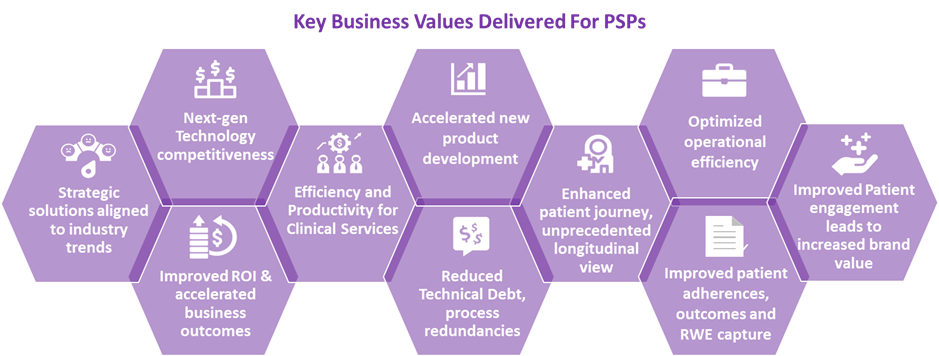Insights
- Specialty drugs have a significant financial impact. To manage the responsibilities of specialty drug manufacturers and optimize client-drug performance, patient support hub services can be leveraged.
- Digital transformation can streamline patient hub services and improve patient engagement, reduce errors, and empower informed decision-making.
- Patient services can be digitally transformed by leveraging cutting-edge technologies like RPA, CRMs, smart eForms, virtual assistants, etc.
Specialty drugs wield a disproportionate financial impact despite constituting a mere 2 to 3 percent of prescriptions. With expenditure on specialty drugs accounting for over half of the total spend, the responsibility falls on specialty drug manufacturers, Providers, and Payers to ensure therapy success, regulatory compliance, and cost containment. This becomes imperative in a market marked by escalating healthcare expenses and a shift toward value-based care.
Specialty drug manufacturers find themselves juggling multiple demands springing from various stakeholders and the ecosystem:
- Pressure from payers: Adhering to multiple cost-containment measures, including tiered co-pays, deductibles, prior authorization, and stringent formulary restrictions.
- Collaboration with providers: Identifying critical-need patients, introducing new drugs, and demonstrating increased value compared to competitive medications.
- Patient-centric focus: Ensuring affordability, effective medication usage, accessibility to support, and adherence to schedules.
- Adverse event reporting: Real-world drug monitoring, including Adverse Event (AE) reporting, which is the responsibility of the specialty drug manufacturers.
Navigating this intricate network of stakeholders and the ecosystem does not come easy!
Evolution of patient hub services
Patient support hub services is a system that offloads these responsibilities from the drug manufacturers. With their ability to bolster conversion rates, accelerate time-to-Rx, and ensure patient adherence to the entire therapy duration, these hubs are a vital cog in the ecosystem.
Traditionally reliant on large call center workforces and diverse communication tools, patient hub services face challenges regarding scalability and efficiency due to escalating volumes. The digital era demands an evolution in these hubs, urging them to embrace transformative changes leveraging technology to bolster revenues, trim expenses, and enhance agent productivity. This, in turn, optimizes client-drug performance and elevates patient engagement and clinical outcomes.

Implementing advanced digital tools for communication, tracking, and record-keeping minimizes errors, enhances data accuracy, and expedites processes.
Need for digital transformation in patient hub services
The existing process flow of hub services entails an intricate web of coordination activities, manual tasks, and repetitive workflows. These activities, while crucial, often impede staff productivity, diverting attention from patient engagement and program optimization.
Embracing digital transformation, however, presents an opportunity to streamline operations and bolster overall efficiency:
- Automation to free up staff: Relying on automation for repetitive tasks frees up valuable human resources, enabling staff to focus on high-impact areas such as patient engagement and outcome improvement.
- Digital tools to reduce errors: Implementing advanced digital tools for communication, tracking, and record-keeping minimizes errors, enhances data accuracy, and expedites processes.
- Scalability to accommodate volumes: Leveraging digital solutions allows for seamless scalability, overcoming the limitations posed by workforce constraints and increasing volumes.
- Personalization for improving adherence: Harnessing technology facilitates personalized patient experiences, fostering better adherence and overall satisfaction.
- Real-Time insights to aid decision-making: Digital transformation enables the collection of real-time data, empowering informed decision-making and facilitating proactive interventions.
The following is a list of high-level tasks and digital transformation steps undertaken under 5 key areas of patient services.
1. Patient intake
High-level process
The patient intake process involves several key steps aimed at ensuring efficient and comprehensive care. It starts with a welcome call, followed by the coordination between healthcare providers (HCPs) and Payers and the documentation of patient details. Assessing the patient's income and status is crucial, leading to the completion of enrolment forms.
Digital transformation
To streamline operations, technologies like robotic process automation (RPA) are leveraged for call center automation. Integration between Customer Relationship Management (CRM) systems and telephony aims to boost agent productivity. Smart eForms are being utilized, auto-filling entries from existing records, while centralized CRMs facilitate patient and provider coordination. E-signatures and consents are centralized, and integration with Electronic Health Records (EHRs) ensures up-to-date patient information. Virtual assistants and chatbots guide patients throughout their journey, enhancing their experience.
2. Patient access
High-level process
Patient access involves various steps, including affordability checks, prior authorization verifications, and validation of plan benefits.
Digital transformation
Digital tools like electronic income validation and automated processes for prior authorization and benefits verification through real-time APIs with payers streamline this phase. Integration with Patient Assistance Programs (PAPs) and co-pay companies helps exchange information electronically, reducing errors and improving efficiency.
3. Patient onboarding
High-level process
The patient onboarding process encompasses drug distribution, patient self-management, education, and co-pay facilitation.
Digital transformation
Digital transformation here involves measures like patient activation measure (PAM) to enhance self-management skills, behavioral tools to assess readiness, and mobile/web-based tools for interaction with healthcare professionals. Automated patient education using technologies like natural language processing (NLP) and chatbots, alongside real-time interfaces with specialty pharmacies, aids in tracking the patient's journey and drug performance.
4. Patient adherence
High-level process
Ensuring patient adherence involves monitoring medication intake, refill outreach, and preventing therapy interruptions.
Digital transformation
Digital tools such as electronic patient-reported outcomes (ePRO) data, smart pillboxes with IoT interfaces, predictive behavioral profiling for adherence outcomes, and mobile apps for reminders support this phase. Additionally, outreach through videos and patient testimonials helps encourage adherence.
5. Program analytics
High-level process
Program analytics play a pivotal role, covering manufacturer reporting, provider outreach planning, patient satisfaction measurement, adverse event tracking, and co-pay program design.
Digital transformation
The digital transformation integrates business intelligence (BI) dashboards for measuring patients' quality of life (QoL), automated alerts based on patient electronic data for adverse events, past program analytics to support patient access teams, and payor analytics to optimize formulary inclusion.
Overall, these comprehensive processes and digital transformations aim to enhance patient care, streamline operations, and optimize healthcare outcomes through a blend of technology, coordination, and patient-centric approaches.

Exhibit 1: Key Business Values Delivered for PSPs
Revolutionizing patient hub services with advanced technologies
Technology plays a pivotal role in every facet of the patient hub services (PSP) model. To facilitate the digital transformation in this domain, a robust technological backend is essential. AWS provides an extensive platform and services ecosystem to cater to PSP’s digital transformation journey. Here's a breakdown of the technologies necessary for this transformation:
- Cloud: Leveraging AWS cloud and its host of services i.e. EC2, Lambda, Elastic Beanstalk, S3, EBS, etc., provide unparalleled performance, elasticity, accessibility, scalability, maintainability, and security, for hosting PSP applications and data, with reduced capital expenditure compared to traditional data centers.
- Customer relationship management (CRM): Implementing a centralized CRM tool like Salesforce can streamline patient journey tracking, task assignment, and process management, enhancing overall efficiency. Services like AWS EventBridge can help integrate Salesforce events with other HUB apps and administrative functions running on AWS.
- Web/mobile portals: These adaptable frontends serve various purposes, such as patient coordination, education, engagement, and portfolio management. Employing responsive, microservices-based designs ensures flexibility and functionality. AWS Amplify is a full solution suite to build scalable and responsive apps, while SNS service can ensure timely notifications to users, for patient journey events.
- Interfaces: Standards-based integrations (HL7, FHIR, EDI, etc.) drawing from diverse sources (EHR, IoMT, PBMs, Payors, HINs, HIEs, pharmacies) enable the creation of comprehensive patient records for swift decision-making. Real-time data processing can be achieved with AWS Kinesis, FHIR endpoints can be configured on Amazon API Gateway, while services like AWS Glue can be used to automate ETL processes.
- APIs: Application programming interfaces offer a swift, reliable method to capture information from multiple sources, replacing traditional interfaces with faster, granular data access. Amazon API Gateway can help create, maintain, and secure APIs at any scale.
- Data: Centralized repositories like enterprise data warehouses (EDW) or data lakes, managed using Amazon Redshift, RDS, and S3 can serve as a single source of truth for multifaceted, rapidly evolving data, empowering teams with accurate information for sales, strategy, clinical, and analytics purposes.
- AI/ML: Advanced analytics models play a pivotal role in assessing patient histories, recommending interventions, and devising more engaging programs. AWS tools like SageMaker make ML deployments at scale feasible for even smaller HUBs, while healthcare specific tools like Amazon comprehend can readily extract clinical information from EHR notes or payor documents.
- Automation: Robotic process automation (RPA) or traditional automation helps eliminate repetitive, error-prone tasks performed by agents, reducing touchpoints and enhancing efficiency. AWS RoboMaker can be used to develop, test, and deploy smart automation bots to improve agent productivity, while Amazon Connect can help integrate RPA with contact center services.
- Cybersecurity: Given the digital nature of transactions and public network use, robust encryption of PHI data and comprehensive vulnerability and threat detection systems are imperative for HIPAA compliance. Secure infrastructure provisioned using Amazon VPC with HIPAA privacy and security controls implemented using services such as IAM (Identity & Access Management), WAF (Web Application Firewall), Certificate Manager, Cognito (Authentication), paired with robust monitoring and logging using CloudWatch and CloudTrail respectively, can ensure a robust, secure healthcare platform on the cloud. AWS Security Hub can help monitor HIPAA compliance and generate action events.
For PSP organizations initiating their digital journey, a phased approach is advisable. Starting with quick wins like ePA, eBV, CRM-telephony integration, and RPA automation can lay the groundwork. Gradually transitioning to more complex initiatives such as cloud adoption, AI/ML integration, and EDWs will require broader organizational consensus and budget. However, this approach will ensure readiness for future demands from patients, providers, and drug manufacturers.
Conclusion
Are you ready to transform patient hub services and revolutionize specialty drug support in the digital age? By integrating cutting-edge technologies, powered through state-of-the-art AWS services, with a steadfast commitment to patient-centric care, we can pave the way for a more efficient, effective, and impactful healthcare future. How will you seize this opportunity to enhance operations, drive innovation, and deliver unparalleled value?






.png?width=1920&height=1080&name=Consulting2_Menu_1%20(1).png)



























































.webp?width=400&height=400&name=The%20future%20of%20Healthcare%20(1).webp)





















.png?width=400&height=400&name=7-Jun-13-2025-02-27-19-6568-PM%20(1).png)






